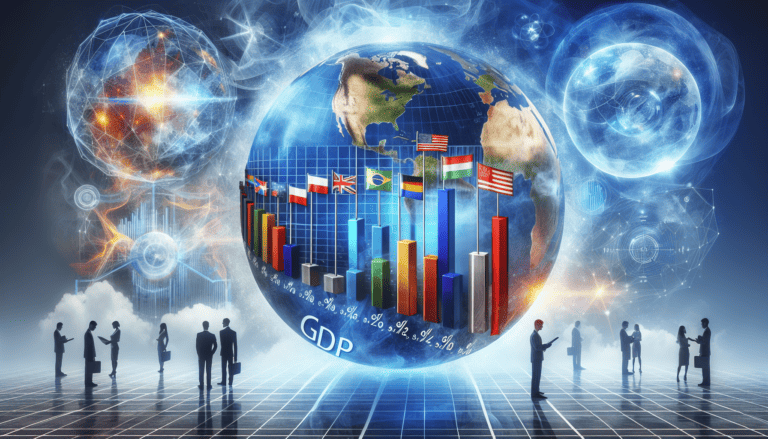The Power Play: How Global Economic Indicators and Interconnectivity Shape Financial Markets

Understanding Economic Indicators
Gaining insight into financial markets begins with understanding economic indicators, which are vital tools for assessing the health of economies. These indicators provide data that inform decisions for investors, policymakers, and business leaders.
Types of Economic Indicators
Economic indicators are classified into different types, each providing unique insights into various aspects of economic performance:
- Leading indicators predict future economic activity, such as the Producer Price Index (PPI) and business confidence surveys.
- Lagging indicators confirm patterns and trends after they occur, including unemployment figures and interest rates set by central banks.
- Coincident indicators reflect the current state of the economy, with Gross Domestic Product (GDP) and retail sales data being prime examples.
Here is a table summarizing these types of indicators:
| Indicator Type | Examples |
|---|---|
| Leading | PPI, Business Confidence Surveys |
| Lagging | Unemployment Figures, Interest Rates |
| Coincident | GDP, Retail Sales |
Interpreting the Data
Interpreting the data from global economic indicators requires an understanding of the broader economic context and how these indicators interact with each other. For instance, an increase in consumer price index (CPI) may signal rising inflation, prompting central banks to adjust interest rates. Meanwhile, a rise in GDP might indicate economic expansion, which could lead to higher corporate earnings and potentially increased stock prices.
Investors should also consider the interconnectedness of the global economy. Economic developments in one country can ripple across borders, affecting global trade balances, currency exchange rates, and investment flows. An informed investor not only looks at the numbers but also analyzes the underlying factors driving those numbers and how they may influence financial markets and investment opportunities.
By monitoring these indicators, stakeholders can make more informed decisions, anticipate economic trends, and understand the implications of various financial strategies. For a deeper dive into specific indicators and their impact on markets, readers may explore topics like housing market indicators, manufacturing and industrial production indexes, or personal income and outlays reports.
The Role of Exchange Rates
In the complex landscape of financial markets, exchange rates hold a pivotal position, influencing trade, investment, and the broader economy. They serve as a critical component among global economic indicators and interconnectivity, impacting the flow of capital and goods across borders.
Exchange Rate Impacts
Exchange rates, the price at which one currency can be exchanged for another, can significantly impact a country’s economic health. Movements in these rates affect key economic indicators such as inflation, employment, and overall economic growth. As reported by Investopedia, these indicators are susceptible to shifts in currency valuations.
For example, a weakening domestic currency can make a nation’s exports more competitive in the global market, potentially stimulating economic activity and job creation. Conversely, a strong currency might make exports more expensive and less attractive to foreign buyers, possibly leading to a trade deficit.
The table below shows how exchange rate variations can influence various economic sectors:
| Sector | Weaker Currency Impact | Stronger Currency Impact |
|---|---|---|
| Exports | Increase competitiveness | Decrease competitiveness |
| Tourism | Attract more visitors | Attract fewer visitors |
| Real Estate | Encourage foreign investment | Discourage foreign investment |
| Government Debt | Increase cost of foreign debt service | Decrease cost of foreign debt service |
These impacts underscore the importance of monitoring exchange rates as part of a comprehensive analysis of global economic indicators.
Currency Fluctuations and Trade
The interplay between currency values and international trade is a critical aspect of global economics. A daily trading volume of approximately $6.6 trillion on the foreign exchange markets reflects the immense scale of these interactions.
For businesses engaged in international trade, exchange rate fluctuations can alter the landscape overnight. Exporters, in particular, may find opportunities in a weaker domestic currency, as their goods become more affordable to foreign buyers, potentially leading to increased demand (Investopedia).
Sectors like tourism and real estate also stand to benefit from a weaker currency. Tourists are more likely to visit a country where their money goes further, and foreign investors may be enticed by lower real estate prices (Investopedia).
Additionally, currency values can impact a nation’s ability to manage its debt, particularly when that debt is held in foreign currencies. A devalued domestic currency can inflate the cost of servicing this debt, whereas a stronger currency can reduce these costs.
Investors and economic policymakers alike must consider the dynamic effects of currency fluctuations on trade. By understanding these relationships, they can make more informed decisions regarding personal income, investment strategies, and economic policies.
The role of exchange rates is a fundamental piece of the puzzle when analyzing global economic indicators and interconnectivity. Through careful examination of these rates, one can gain deeper insights into the current state and potential future directions of financial markets.
Measuring Global Economic Health
Evaluating the health of the global economy is a complex task that requires an understanding of various economic indicators. These indicators provide insights into the economic activity and trends that shape our world. In this section, we will explain one of the most critical indicators, the Gross Domestic Product (GDP), and explore additional metrics that offer a more comprehensive view of economic health.
GDP Explained
Gross Domestic Product, or GDP, is a principal gauge of a country’s economic health, representing the total monetary value of all final goods and services produced within a nation’s borders over a specified period, typically a year or a quarter. It encapsulates the output of market and some nonmarket productions like government services (IMF – Back to Basics).
To calculate GDP, economists typically use one of three methods: the production approach, the expenditure approach, or the income approach. Each offers a different perspective but should theoretically result in the same GDP figure. Real GDP, which adjusts for inflation, is used to assess the economy’s general health, with growth indicating a robust economy and contraction suggesting a decline.
GDP is also vital for comparing economic productivity across countries, with adjustments for U.S. dollars made using market exchange rates or purchasing power parity (PPP) to reflect more accurately the relative value of goods and services (IMF – Back to Basics).
| Economic Indicator | Description |
|---|---|
| GDP (Nominal) | Measures the value of all finished goods and services at current market prices. |
| GDP (Real) | Adjusts nominal GDP for changes in price or inflation, reflecting the actual growth in goods and services. |
| GDP (PPP) | Compares different countries’ GDP using a basket of goods approach to account for purchasing power differences. |
For more on how GDP impacts markets, visit understanding gdp and its market impact.
Beyond GDP
While GDP is an essential tool for measuring economic performance, it does not encompass all aspects of economic health. For instance, it excludes unpaid work such as household chores and volunteer activities, as well as black market transactions, due to the challenges in measuring and valuing these activities accurately (IMF – Back to Basics).
To obtain a more nuanced understanding of economic health, analysts may consider additional indicators such as:
- Inflation rates and financial markets
- Unemployment figures and economic health
- Consumer Price Index (CPI) explained
- Housing market indicators and trends
- Manufacturing and industrial production indexes
These indicators offer different perspectives on the economy’s state, such as consumer spending, job market health, and production activity. Additionally, understanding alternative measures like the Human Development Index (HDI), which considers education, life expectancy, and income, provides a broader view of societal progress.
Together, these global economic indicators and interconnectivity paint a comprehensive picture of economic health, guiding policymakers, investors, and businesses through the intricacies of the financial landscape. They help stakeholders anticipate economic trends, make informed decisions, and form strategies to mitigate risks and capitalize on opportunities in the interconnected global economy (SAGE Publications).
The Impact of Globalization
Globalization has fundamentally reshaped the economic landscape, influencing everything from individual livelihoods to the collective fate of nations. It has brought about a degree of interconnectedness that has unprecedented implications for financial markets and the world economy.
Benefits to Developing Nations
Globalization has been a catalyst for economic growth in many developing countries. It has enabled these nations to tap into international trade and investment, leading to job creation and improved standards of living. In Vietnam, for instance, the rise in rice prices due to global trade has lifted numerous rice farmers out of poverty, allowing their children to forgo work in favor of education, as detailed by National Geographic. This shift has contributed to broader social improvements and enhanced living standards.
Additionally, businesses in developing countries benefit from globalization by exploiting lower labor costs and combining them with the technical expertise and experience from more developed economies. The garment industry in Bangladesh is a prime example, employing around four million people and providing a competitive advantage through the sourcing of inexpensive raw materials and the potential for reduced production costs (National Geographic).
Globalization has also fostered social interconnectedness, facilitating the exchange of ideas and cultures. This cultural diffusion has led to a more tolerant worldview, with people becoming increasingly open to different cultures and perspectives.
Challenges and Disparities
However, globalization also presents significant challenges and exacerbates disparities within and among countries. One of the stark realities of globalization is income inequality, both within nations and on a global scale. The garment industry in Bangladesh, while providing employment opportunities, also highlights wage disparities, with the average worker earning less in a month than a U.S. worker earns in a day (National Geographic).
For unskilled workers, globalization can mean declining wages and job insecurity as the pressures of global competition put constant pressure on wages. Studies suggest that globalization may contribute to widening the income gap between more educated and less educated members of society, with those lacking specialized skills being the most vulnerable (National Geographic).
Moreover, the rapid pace of globalization can lead to environmental degradation and exploitation of natural resources, as countries prioritize economic growth over sustainability. The challenge is to balance economic growth with environmental stewardship and social equity.
Globalization’s impact on financial markets is complex and multifaceted. Understanding this interplay is crucial for beginner investors who can use global economic indicators and interconnectivity to inform their investment decisions. For further insights into how various indicators affect financial markets, readers can explore topics such as inflation rates and financial markets or delve into the significance of consumer price index (CPI) explained. For those interested in how different sectors respond to economic signals, resources on manufacturing and industrial production indexes or housing market indicators and trends can provide valuable context.
Interconnectivity in Finance
The finance sector is a web of interconnected markets and institutions operating on a global scale. The links between economies mean that an event in one part of the world can have ripple effects across the globe.
Market Dynamics
Market dynamics in finance are influenced by a myriad of factors, including global economic indicators and interconnectivity. These indicators provide crucial data that reflects the health and trends of economies. When investors understand these indicators, they can make more informed decisions. For example, interest rate decisions by central banks can influence currency values and therefore impact international investment flows.
Moreover, the interconnectivity of financial markets means that they are sensitive to changes in other markets. A shift in the housing market indicators and trends in one country, for instance, can affect the global real estate investment trusts. Similarly, consumer confidence index and spending behavior in a significant economy can sway stock markets worldwide due to the anticipation of future sales by multinational corporations.
Supply Chain Considerations
Supply chains are the backbone of global trade and economic stability. They represent the complex network of steps taken to bring a product from its raw form to the consumer. In the context of finance, supply chain health can indicate economic vitality or vulnerabilities.
The COVID-19 pandemic has underlined the interconnectedness of the global economy, leading to disruptions in trade, tourism, and supply chains. This highlighted the vulnerability of the global economic system to widespread shocks, as reported by the Congressional Research Service. Disruptions can arise from various factors such as natural disasters or geopolitical tensions, affecting industries worldwide.
Inadequate vaccination rates in developing countries could prolong the pandemic, further straining the global economy. Unequal access to vaccines may lead to prolonged restrictions and economic disparities between nations, hindering overall recovery efforts worldwide. Such disparities can influence investor behavior, as seen in the consumer price index (CPI) explained, where rising inflation rates in one country can affect purchasing power and investment potential.
Investors must consider the robustness of supply chains when evaluating the stability and growth prospects of different sectors. For instance, commodity prices as economic indicators can signal changes in supply and demand dynamics, while manufacturing and industrial production indexes reflect the output capabilities and potential bottlenecks in production.
The interconnectivity in finance, as highlighted by these market dynamics and supply chain considerations, showcases the importance of having a holistic view of both economic indicators and the underlying structures that support global trade. Understanding these connections helps investors navigate the complexities of financial markets and make more strategic investment decisions.
Key Global Indicators
Global economic indicators are vital tools for investors, analysts, and policymakers to assess the health of economies and predict future market trends. Understanding these indicators and their interconnectedness is essential for beginner investors looking to make informed financial decisions.
Baltic Dry Index
The Baltic Dry Index (BDI) is a crucial indicator for international trade, as it reflects the demand for shipping capacity versus the supply of dry bulk carriers. It serves as a leading indicator for economic growth and production since the goods transported are typically raw materials essential for manufacturing. A high BDI suggests strong demand for raw materials and a bustling global economy, while a low BDI may signal economic slowdown or oversupply issues. This index can be particularly insightful for investors interested in commodity markets and trade-related stocks.
| BDI Rating | Economic Implication |
|---|---|
| High | Strong demand for commodities, robust economic activity |
| Low | Decreased demand, potential economic downturn |
Source: Investopedia
Leading Economic Index
The Leading Economic Index (LEI) is a composite of 10 economic indicators that collectively offer a forecast of future economic activity. These indicators include data points such as manufacturers’ new orders, stock prices, and consumer expectations, among others. A rising LEI predicts positive economic growth, whereas a declining LEI may indicate a potential recession. Investors use the LEI to adjust their investment strategies accordingly, anticipating how the economy will perform in the coming months.
For a deeper understanding of how these indicators affect financial markets, consider exploring inflation rates and financial markets and interest rate decisions by central banks.
Purchasing Managers’ Index
The Purchasing Managers’ Index (PMI) offers timely insights into the economic health of the manufacturing and service sectors. This index is derived from monthly surveys of private sector companies, providing data on new orders, inventory levels, production, supplier deliveries, and employment. A PMI value above 50 indicates sector expansion, while below 50 suggests contraction. It is a closely watched indicator, as it can signal early shifts in economic activity. Investors might use the PMI to make decisions related to industrial and manufacturing stocks, and to gauge overall market sentiment.
Discover more about the PMI and its influence on market dynamics by visiting pmi: manufacturing and services sector insights.
Consumer Price Index
The Consumer Price Index (CPI) is a critical measure of inflation, reflecting changes in the cost of a basket of goods and services typically purchased by urban consumers. The CPI affects consumer purchasing power and economic stability, and it is a key factor that central banks consider when setting monetary policy. Changes in CPI can influence investor behavior, as rising inflation may lead to higher interest rates, affecting bond and stock market performance. For investors, understanding CPI trends is vital for making decisions about asset allocation and risk management.
| CPI Trend | Investor Implication |
|---|---|
| Rising Inflation | Potential for higher interest rates, cautious investing |
| Stable/Low Inflation | Favorable conditions for equities, growth investing |
For further details on how CPI affects financial decisions, readers may refer to consumer price index (cpi) explained.
By keeping track of these indicators, investors can better navigate the complexities of the financial markets. Each of these indices provides a snapshot of different aspects of the global economy, allowing investors to piece together a broader picture of economic health and make more strategic investment choices.
Influences on Investment Decisions
The decisions investors make are significantly influenced by various global economic indicators. These indicators offer insights into economic trends and help forecast future market directions. Understanding them is pivotal for beginner investors looking to navigate the complexities of financial markets.
Analyzing the LEI
The Conference Board Leading Economic Index (LEI) serves as a barometer for the future health of the economy. It combines 10 economic indicators, including manufacturers’ new orders, stock prices, and consumer expectations, to provide a forward-looking perspective on economic activity. Investors often rely on the LEI to anticipate market trends and make proactive investment decisions.
| LEI Component | Description |
|---|---|
| Average weekly hours | Manufacturing |
| Average weekly initial claims | Unemployment insurance |
| Manufacturers’ new orders | Consumer goods and materials |
| ISM Index of New Orders | Manufacturing |
| Building permits | New private housing units |
| Stock prices | 500 common stocks |
| Leading Credit Index™ | |
| Interest rate spread | 10-year Treasury bonds less federal funds |
| Average consumer expectations | Business conditions |
By analyzing shifts in the LEI, investors can gauge whether the economy is likely to expand or contract in the near future. This can influence decisions such as asset allocation, sector investment, and risk assessment. For a deeper understanding of how the LEI can impact investment strategies, visit understanding GDP and its market impact.
PMI and Market Movements
The Purchasing Managers’ Index (PMI) is a pivotal indicator of the economic health of the manufacturing and service sectors. It’s based on surveys of purchasing managers and covers aspects like new orders, inventory levels, production, supplier deliveries, and employment. A PMI above 50 signals expansion, while below 50 indicates contraction.
Investors monitor PMI data to understand sector-specific economic conditions, which can profoundly affect stock market movements and sector investments. Positive PMI readings can lead to bullish market sentiment, while negative readings can signal bearish trends. For insights into how PMI reflects the health of the manufacturing and services sectors, check out PMI: manufacturing and services sector insights.
CPI and Investor Behavior
The Consumer Price Index (CPI) measures the average change in prices over time that consumers pay for a basket of goods and services. It is a crucial indicator of inflation, which affects consumers’ purchasing power and overall economic stability. Rising CPI figures might indicate increased inflation, which can lead to higher interest rates as a countermeasure by the central banks.
Investors keep a close eye on CPI data as it can influence stock and bond markets. High inflation rates typically decrease the value of future cash flows, leading to a decrease in stock prices. On the other hand, low inflation may lead to lower interest rates and can be positive for stocks. To understand how inflation influences financial markets, visit inflation rates and financial markets.
The interplay of these global economic indicators and the interconnectivity of financial markets underscore the complexity of investment decisions. Beginner investors can leverage this knowledge to construct well-informed investment strategies that take into account the multifaceted nature of the global economy.
Economic Organizations and Policies
In the arena of global finance, economic organizations and policies play a pivotal role in shaping markets and influencing investment decisions. Understanding the functions and impacts of these organizations is essential for beginner investors aiming to grasp the world of financial markets.
The Role of the IMF
The International Monetary Fund (IMF), founded in July 1944 at the United Nations Bretton Woods Conference, is a key institution in global economic governance. The IMF’s primary purpose is to ensure the stability of the international monetary system—the system of exchange rates and international payments that enables countries to transact with each other (IMF). Here’s how the IMF influences global markets:
- Crisis Response: The IMF provides financial assistance to countries in economic distress. An example of this is during the Covid-19 pandemic when the IMF increased access to funds and emergency financing (IMF).
- Special Drawing Rights (SDRs): This international reserve asset allows member countries to exchange currencies, providing liquidity in times of need (IMF).
- Technical Assistance: The IMF offers guidance to member countries on economic policies and institutional reforms (IMF).
The IMF’s actions can affect inflation rates and financial markets, influence government budget deficits and public debt, and play a role in determining interest rate decisions by central banks.
The Influence of the World Bank
Parallel to the IMF, the World Bank focuses on long-term economic development and poverty reduction. It provides financial and technical assistance to developing countries for various projects, such as improving education, healthcare, and infrastructure (IMF). The World Bank’s influence manifests in several ways:
- Project Financing: The World Bank funds projects that can have significant impacts on a country’s economy, such as those related to housing market indicators and trends.
- Poverty Reduction: By focusing on economic reforms, the World Bank aims to lift populations out of poverty, affecting consumer confidence index and spending behavior.
- Sustainable Development: Support for achieving Sustainable Development Goals can lead to changes in commodity prices as economic indicators.
Collaborative Global Responses
The IMF and the World Bank often collaborate to address global challenges, providing a unified response to economic issues. They assess financial stability, work towards reducing debt burdens in impoverished nations, and support countries in attaining Sustainable Development Goals (IMF). Collaborative efforts include:
- Joint Assessments: Evaluating the financial health and stability of member countries, impacting personal income and outlays report and business confidence and investment surveys.
- Debt Relief: Initiatives to alleviate debt in poor countries affect non-farm payrolls and labor market trends and money supply measures and monetary policy.
- Climate Change: Addressing environmental impact on economic growth influences manufacturer and industrial production indexes and durable goods orders and economic forecasting.
These organizations and their policies are fundamental in understanding the interconnectedness of global financial markets and the importance of global economic indicators and interconnectivity. Investors should keep an eye on the activities and reports from the IMF and World Bank, as they can provide valuable insights into global economic trends and potential investment opportunities.
Global Trade and Investment Flows
Exploring the intricacies of global economic indicators and interconnectivity, it’s essential to understand how trade and investment flows play a pivotal role in shaping financial markets. These flows are critical components that reflect the health of the global economy and directly influence investment decisions.
Trends in World Trade
The global landscape of trade has seen a marked expansion over the past few decades. According to the IMF, the volume of world trade has increased fivefold since 1980. This surge has been fueled by the liberalization of trade and advancements in technology, which have made it easier and more cost-effective to move goods across borders. World exports relative to output grew from 20 percent in 1995 to 30 percent in 2008, indicating the increasing integration of global economies.
| Year | World Exports (% of Global Output) |
|---|---|
| 1995 | 20% |
| 2008 | 30% |
The prominence of world trade underscores the need for investors to monitor trade balance and its effect on currency values and understand how shifts in global production can influence market trends.
Capital Flows and Economic Stability
Capital flows, the movement of money for the purpose of investment, trade, or business production, are a significant indicator of economic health. As per the IMF, global capital flows were more than triple their level in 1995 by the time of the financial crisis. These flows affect the stability of economies, as they can lead to an increase in investment and economic growth or cause financial instability if they are volatile and speculative.
| Period | Global Capital Flows |
|---|---|
| Pre-1995 | Lower levels |
| Pre-crisis | Triple of 1995 levels |
Investors should consider the impact of capital flows when evaluating the stability of potential investments and the broader economic environment. This includes paying attention to interest rate decisions by central banks and government budget deficits and public debt.
The US in the Global Economy
The role of the United States in the global economy cannot be overstated. It accounts for 11 percent of global trade and 20 percent of global manufacturing value-added, as stated by the IMF. The interconnectedness of the US economy with the rest of the world is evident in the assets and claims held by banks. Foreign banks hold about $5½ trillion of U.S. assets, while American banks hold approximately $3 trillion of foreign claims. Moreover, nearly half of the sales from companies in the S&P 500 stem from foreign operations.
| Entity | Holdings |
|---|---|
| Foreign Banks in the US | $5.5 trillion US assets |
| US Banks Abroad | $3 trillion foreign claims |
This interlinking of financial interests highlights why developments in the US economy, such as non-farm payrolls and labor market trends or the consumer price index (CPI) explained, are watched closely by investors worldwide. The US not only plays a pivotal role in influencing global economic health but also serves as a barometer for international financial market sentiment.





